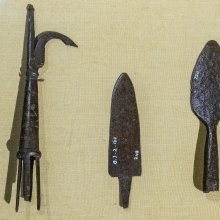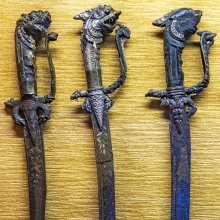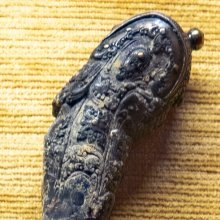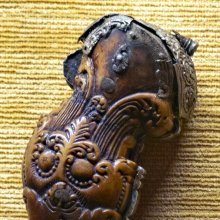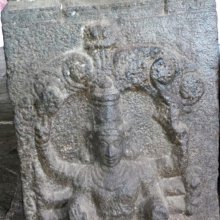Ayudha, Āyudha: 28 definitions
Introduction:
Ayudha means something in Hinduism, Sanskrit, Jainism, Prakrit, Buddhism, Pali, Marathi, Hindi. If you want to know the exact meaning, history, etymology or English translation of this term then check out the descriptions on this page. Add your comment or reference to a book if you want to contribute to this summary article.
Alternative spellings of this word include Aayudh.
Images (photo gallery)
(+16 more images available)
In Hinduism
Vastushastra (architecture)
Source: Sreenivasarao's blogs: Temple Architecture – Devalaya Vastu – Part sevenAyudha generally translates to weapons; but, in shilpa-sastra, the term indicates whatever objects the idol holds in his or her hands. The Ayudhas delineate the nature, character and functions associated with the idol. In a way of speaking, they are the symbols of a symbolism. For instance, Saraswathi holds in her hands a book symbolizing the Vedas and learning; a Kamandala (a water jug) symbolizing smruthi, vedanga and shastras; a rosary symbolizing the cyclical nature of time; and the musical instrument veena symbolizing music and her benevolent nature.
All these objects are not weapons in the conventional sense, but the shilpa employs those as symbols to expand and depict and interpret the nature of the idol and its meaning. Each of these Ayudhas signifies a certain aspect or it stands for a concept. For instance, the mirror signifies a clear mind and awareness; the flag signifies victory or celebration; the Ankusha (goad) signifies exercising control over senses and baser instincts, Damaru in the hands of shiva signifies creation and origin of sound and learning; and, the scepter signifies authority and rule of law.

Vastushastra (वास्तुशास्त्र, vāstuśāstra) refers to the ancient Indian science (shastra) of architecture (vastu), dealing with topics such architecture, sculpture, town-building, fort building and various other constructions. Vastu also deals with the philosophy of the architectural relation with the cosmic universe.
Purana and Itihasa (epic history)
Source: archive.org: Shiva Purana - English TranslationAyudha (अयुध) refers to the “weapons” (of the Gods), according to the Śivapurāṇa 2.3.17 (“The dialogue between Indra and Kāmadeva”).—Accordingly, as Brahmā said to Kāma: “[...] Securing a wonderful boon from Brahmā, the great demon Tāraka has become invincible and a pest for everyone. The entire world is harassed by him. Many virtuous rites are destroyed. The gods have become miserable and so also the sages. He had been fought by the gods to the utmost of their ability formerly. But the weapons [i.e., ayudha] of all the gods became quite futile. [...]”.
Source: Cologne Digital Sanskrit Dictionaries: The Purana IndexĀyudha (आयुध).—Weapons of war, enumerated and described.*
- * Brahmāṇḍa-purāṇa IV. 22. 10-14; Matsya-purāṇa 129. 35; 149. 7-8; 173. 5, 12, 29, etc.

The Purana (पुराण, purāṇas) refers to Sanskrit literature preserving ancient India’s vast cultural history, including historical legends, religious ceremonies, various arts and sciences. The eighteen mahapuranas total over 400,000 shlokas (metrical couplets) and date to at least several centuries BCE.
Shilpashastra (iconography)
Source: Shodhganga: The significance of the mūla-beras (śilpa)Āyudha (आयुध) refers to the “attributes” or “accessories” of a detiy, as defined in the texts dealing with śilpa (arts and crafs), known as śilpaśāstras.—The technical terms of the attributes (āyudha) relate to the objects which the images of Hindu gods and goddesses are shown as bearing in their hands, such as weapons, musical instruments, animals, and birds. The attributes (āyudha) also relate to the various attitudes in which the hands of images are shown and the postures which the bodies of the images are made to assume. The attributes include the costume, ornaments and head gear in which they are represented. The śilpa texts have classified the various accessories under the broad heading of āyudha or karuvi (implement), including even flowers, animals, and musical instruments.
Source: Shodhganga: Vaisnava Agamas And Visnu ImagesĀyudha (आयुध) refers to “attributes” or “weapons”, as defined in treatises such as the Pāñcarātra, Pādmasaṃhitā and Vaikhānasa-āgamas, extensively dealing with the technical features of temple art, iconography and architecture in Vaishnavism.

Shilpashastra (शिल्पशास्त्र, śilpaśāstra) represents the ancient Indian science (shastra) of creative arts (shilpa) such as sculpture, iconography and painting. Closely related to Vastushastra (architecture), they often share the same literature.
Shaktism (Shakta philosophy)
Source: Google Books: ManthanabhairavatantramĀyudha (आयुध) refers to the “weapons” (of the Goddesses), according to the Ṣaṭsāhasrasaṃhitā, an expansion of the Kubjikāmatatantra: the earliest popular and most authoritative Tantra of the Kubjikā cult.—Accordingly, “Having (mentally) formed (the twenty-four sacred places) beginning with Aṭṭahāsa and ending with Rājagṛha along with the goddesses with (their) weapons [i.e., āyudha] and accompanied by the guardians, by attending the sacred fields, primary and secondary, and the meeting places, he becomes pure. O dear one, he who is incompetent or careless (but nevertheless) gets up in the morning and recites (this hymn) achieves perfect purity by eulogizing the sacred seats. I will tell (you) that so that (the observance of) the Rule may be purified”.
Source: Brill: Śaivism and the Tantric Traditions (shaktism)Ayudha (अयुध) refers to the “weapon-forms (of the deities of the weapons of the Goddesses)”, according to the King Vatsarāja’s Pūjāstuti called the Kāmasiddhistuti (also Vāmakeśvarīstuti), guiding one through the worship of the Goddess Nityā.—Accordingly, “[...] I worship those eight goddesses of speech, Vaśinī and others, whose complexion is red. They carry in their four lovely hands a bow, arrows, a book, and a rosary. May the four deities of the weapons [of the Goddess]—the arrows and others—red in complexion, displaying the gestures of generosity and protection, marked on the head by their own respective weapon-forms (ayudha-devatā), grant me permission [for worship of the Goddess]. [...]”.

Shakta (शाक्त, śākta) or Shaktism (śāktism) represents a tradition of Hinduism where the Goddess (Devi) is revered and worshipped. Shakta literature includes a range of scriptures, including various Agamas and Tantras, although its roots may be traced back to the Vedas.
Jyotisha (astronomy and astrology)
Source: Wisdom Library: Brihat Samhita by Varahamihira1) Āyudha (आयुध) or Āyudhajīvin refers to “artisans”, according to the Bṛhatsaṃhitā (chapter 4), an encyclopedic Sanskrit work written by Varāhamihira mainly focusing on the science of ancient Indian astronomy astronomy (Jyotiṣa).—Accordingly, “If the Moon (candra) should be eclipsed by Ketu she will destroy prosperity, health and plenty. Artisans will perish [i.e., āyudha-jīvin-vināśa] and thieves will suffer greatly. If while the moon is eclipsed, she be crossed by the fall of a meteor, that prince will die in the star of whose nativity the moon then happens to be”.
2) Āyudha (आयुध) (Cf. Āyudhīya) refers to “weapons”, according to the Bṛhatsaṃhitā (chapter 5).—Accordingly, “If the sun and moon should begin to be eclipsed when only half risen, deceitful men will suffer as well as sacrificial rites. [...] If they should be eclipsed when in the sign of Sagittarius (Dhanuṣa), ministers, fine horses, the Videhas, the Mallānas, the Pāñcālas, physicians, merchants and persons skilled in the use of destructive weapons [i.e., viṣama-āyudha-jñā] will perish. If when in the sign of Capricornus (Makara), fishes, the families of ministers, the Cāṇḍālas, skilled magicians, physicians and old soldiers will perish”.

Jyotisha (ज्योतिष, jyotiṣa or jyotish) refers to ‘astronomy’ or “Vedic astrology” and represents the fifth of the six Vedangas (additional sciences to be studied along with the Vedas). Jyotisha concerns itself with the study and prediction of the movements of celestial bodies, in order to calculate the auspicious time for rituals and ceremonies.
Shaivism (Shaiva philosophy)
Source: Google Books: Manthanabhairavatantram (shaivism)Āyudha (आयुध) refers to the “weapons” or “attributes” (of Svacchanda), according to the Śrīmatottara-tantra, an expansion of the Kubjikāmatatantra: the earliest popular and most authoritative Tantra of the Kubjikā cult. Accordingly, “O goddess, Svacchanda is in the middle, within the abode of the triangle. Very powerful, he has five faces with three times five flaming eyes. [...] O fair lady, my attributes—trident, dagger, sword, the king of the snakes, and rosary—adorn the right (arms). O beloved, a skull, double-headed drum, javelin, noose and goad—(these) are my divine, brilliant and very auspicious weapons [i.e., āyudha] that (are held) in the left (hands). The king of snakes (hangs) on the shoulder and a garland of skulls hangs (from the neck). There is a necklace of scorpions around the throat and the ears are adorned with snakes. [...]”.
Source: SOAS University of London: Protective Rites in the Netra TantraĀyudha (आयुध) refers to a “hatchet”, according to the Netratantra of Kṣemarāja: a Śaiva text from the 9th century in which Śiva (Bhairava) teaches Pārvatī topics such as metaphysics, cosmology, and soteriology.—Accordingly, [verse 10.1-7ab, while describing the appearance and worship of Bhairava]—“[...] He] bears a sword and shield, holds a hook and noose. [His] hand[s and posed] in the wish fulfilling and protection [mudrās. He] holds the thunderbolt of a great hero. [He also] holds an axe and a hatchet (āyudha—paraśvāyudhapāṇikam). Having worshipped Bhairava, [the Mantrin] remembers being joined in union [with] him, [in the same way as] dissolution in fire”.

Shaiva (शैव, śaiva) or Shaivism (śaivism) represents a tradition of Hinduism worshiping Shiva as the supreme being. Closely related to Shaktism, Shaiva literature includes a range of scriptures, including Tantras, while the root of this tradition may be traced back to the ancient Vedas.
Vaishnavism (Vaishava dharma)
Source: Brill: Śaivism and the Tantric Traditions (vaishnavism)Āyudha (आयुध) refers to the “(five) weapons (of Murāri)”, according to the Vedānta Deśika’s Yatirājasaptati.—When we come to the poem’s understanding of the divinity of Rāmānuja we find a wide spectrum of meanings. In verse 12, which agrees with verse 33 of the Irāmāṉuja Nūṟṟantāti, Rāmānuja is seen as the coming together of all the five weapons (pañca-āyudha) of Murāri [apṛthakpratipanna yanmayatvaiḥ vavṛdhe pañcabhir āyudhair murāreḥ, 12cd].

Vaishnava (वैष्णव, vaiṣṇava) or vaishnavism (vaiṣṇavism) represents a tradition of Hinduism worshipping Vishnu as the supreme Lord. Similar to the Shaktism and Shaivism traditions, Vaishnavism also developed as an individual movement, famous for its exposition of the dashavatara (‘ten avatars of Vishnu’).
In Jainism
General definition (in Jainism)
Source: The University of Sydney: A study of the Twelve ReflectionsAyudha (अयुध) refers to a “weapon”, according to the 11th century Jñānārṇava, a treatise on Jain Yoga in roughly 2200 Sanskrit verses composed by Śubhacandra.—Accordingly, “This most powerful [and] cruel death devours against their will the life of those who possess a body that has settled in the middle world, in hell, in the world of Brahmā, in Indra’s abode, in the middle of the ocean, inside the forest, at all quarters of the globe, on a mountain-peak, in a place difficult of access on account of fire, forest, cold, darkness, thunderbolts [and] swords [com.—indra-ayudha—‘Indra’s weapon’], or in [a place] crowded with a troop of ruttish elephants”.

Jainism is an Indian religion of Dharma whose doctrine revolves around harmlessness (ahimsa) towards every living being. The two major branches (Digambara and Svetambara) of Jainism stimulate self-control (or, shramana, ‘self-reliance’) and spiritual development through a path of peace for the soul to progess to the ultimate goal.
Languages of India and abroad
Pali-English dictionary
Source: BuddhaSasana: Concise Pali-English Dictionaryāyudha : (nt.) weapon.
Source: Sutta: The Pali Text Society's Pali-English DictionaryĀyudha, is the Vedic form of the common Pāli form āvudha weapon, and occurs only spuriously at D. I, 9 (v. l. āvudha). (Page 106)

Pali is the language of the Tipiṭaka, which is the sacred canon of Theravāda Buddhism and contains much of the Buddha’s speech. Closeley related to Sanskrit, both languages are used interchangeably between religions.
Marathi-English dictionary
Source: DDSA: The Molesworth Marathi and English Dictionaryāyudha (आयुध).—n (S) A weapon. 2 Laxly. An implement or a tool.
Source: DDSA: The Aryabhusan school dictionary, Marathi-Englishāyudha (आयुध).—n A weapon; a tool.
Marathi is an Indo-European language having over 70 million native speakers people in (predominantly) Maharashtra India. Marathi, like many other Indo-Aryan languages, evolved from early forms of Prakrit, which itself is a subset of Sanskrit, one of the most ancient languages of the world.
Sanskrit dictionary
Source: DDSA: The practical Sanskrit-English dictionaryAyudha (अयुध).—A non-combatant.
Derivable forms: ayudhaḥ (अयुधः).
--- OR ---
Āyudha (आयुध).—[āyudh-ghañarthe ka]
1) A weapon, shield &c.; it is of 3 kinds (1) प्रहरण (praharaṇa), e. g. a sword; (2) हस्तमुक्त (hastamukta), e. g. a disc; (3) यन्त्रमुक्त (yantramukta), e. g. an arrow; आयुधानामहं वज्रम् (āyudhānāmahaṃ vajram) Bhagavadgītā (Bombay) 1.28. न मे त्वदन्येन विसोढमायुधम् (na me tvadanyena visoḍhamāyudham) R.3.63. An implement; वशाया यज्ञ आयुधम् (vaśāyā yajña āyudham) Av.1.1.18.
2) A vessel (Ved.).
-dham 1 Gold used for ornaments.
2) (pl.) Water (Ved.).
Derivable forms: āyudhaḥ (आयुधः), āyudham (आयुधम्).
Source: Cologne Digital Sanskrit Dictionaries: Shabda-Sagara Sanskrit-English DictionaryĀyudha (आयुध).—m.
(-dhaḥ) A weapon in general. E. āṅ before yudh to fight, ka aff.
Source: Cologne Digital Sanskrit Dictionaries: Benfey Sanskrit-English DictionaryĀyudha (आयुध).—[ā-yudh + a], n., A weapon, [Mānavadharmaśāstra] 7, 93.
Source: Cologne Digital Sanskrit Dictionaries: Cappeller Sanskrit-English DictionaryĀyudha (आयुध).—[neuter] weapon, vessel; adj. —° armed with.
Source: Cologne Digital Sanskrit Dictionaries: Monier-Williams Sanskrit-English Dictionary1) Ayudha (अयुध):—[=a-yudha] [from a-yuddha] m. a non-fighter, [Pāṇini 5-1, 121.]
2) Āyudha (आयुध):—[=ā-yudha] [from ā-yudh] n. a weapon, [Ṛg-veda; Atharva-veda; Vājasaneyi-saṃhitā; Rāmāyaṇa; Manu-smṛti; Mahābhārata; Raghuvaṃśa] etc.
3) [v.s. ...] implement, [Atharva-veda x, 10, 18; Aitareya-brāhmaṇa; Kauśika-sūtra]
4) [v.s. ...] gold used for ornaments, [cf. Lexicographers, esp. such as amarasiṃha, halāyudha, hemacandra, etc.]
5) [v.s. ...] n. [plural] water, [cf. Lexicographers, esp. such as amarasiṃha, halāyudha, hemacandra, etc.]
Source: Cologne Digital Sanskrit Dictionaries: Yates Sanskrit-English DictionaryĀyudha (आयुध):—[ā-yudha] (dhaḥ) 1. m. Weapon in general.
Source: DDSA: Paia-sadda-mahannavo; a comprehensive Prakrit Hindi dictionary (S)Āyudha (आयुध) in the Sanskrit language is related to the Prakrit words: Āuha, Ājuha.
[Sanskrit to German]
Sanskrit, also spelled संस्कृतम् (saṃskṛtam), is an ancient language of India commonly seen as the grandmother of the Indo-European language family (even English!). Closely allied with Prakrit and Pali, Sanskrit is more exhaustive in both grammar and terms and has the most extensive collection of literature in the world, greatly surpassing its sister-languages Greek and Latin.
Hindi dictionary
Source: DDSA: A practical Hindi-English dictionaryĀyudha (आयुध) [Also spelled aayudh]:—(nm) armament; arms, weapons; ~[jīvī] a professional soldier; ~[śālā] armoury, arsenal.
...
Kannada-English dictionary
Source: Alar: Kannada-English corpusĀyudha (ಆಯುಧ):—
1) [noun] an instrument or device of any kind used to injure or kill, as in fighting or hunting; a weapon.
2) [noun] any implement, instrument or utensil held in the hand and used for cutting, hitting, digging, rubbing, etc; a tool.
Kannada is a Dravidian language (as opposed to the Indo-European language family) mainly spoken in the southwestern region of India.
Nepali dictionary
Source: unoes: Nepali-English DictionaryĀyudha (आयुध):—n. 1. a weapon; shield; 2. a vessel; 3. an armor;
Nepali is the primary language of the Nepalese people counting almost 20 million native speakers. The country of Nepal is situated in the Himalaya mountain range to the north of India.
See also (Relevant definitions)
Starts with (+15): Ayudhabhrit, Ayudhadhari, Ayudhadharini, Ayudhadharmini, Ayudhadharmmini, Ayudhadhyaksha, Ayudhagar, Ayudhagara, Ayudhagaranara, Ayudhagarika, Ayudhajivin, Ayudhajna, Ayudhakara, Ayudham, Ayudhapala, Ayudhapani, Ayudhapanika, Ayudhapariksha, Ayudhapishachika, Ayudhapishaci.
Ends with (+98): Adayudha, Addayudha, Aindrayudha, Alayudha, Anayudha, Asamayudha, Ashtayudha, Baddhayudha, Bhadrayudha, Bhairavayudha, Bhujayudha, Cakrayudha, Camdrayudha, Capayudha, Caranayudha, Chakrayudha, Chandoratnahalayudha, Charanayudha, Chhandoratnahalayudha, Chitrayudha.
Full-text (+269): Nirayudha, Caranayudha, Ayudhagara, Ayudhajivin, Ayudhashala, Ayudhadharmini, Dantayudha, Ayudhapishacika, Halayudha, Ayudhapishaci, Kusumayudha, Ayudhasahaya, Ayudhapala, Ayudhasahvaya, Ayudhabhrit, Tridashayudha, Kaushikayudha, Potrayudha, Katayutam, Dridhayudha.
Relevant text
Search found 24 books and stories containing Ayudha, Āyudha, A-yudha, Ā-yudha; (plurals include: Ayudhas, Āyudhas, yudhas). You can also click to the full overview containing English textual excerpts. Below are direct links for the most relevant articles:
Rig Veda (translation and commentary) (by H. H. Wilson)
Rudra-Shiva concept (Study) (by Maumita Bhattacharjee)
2. Vājasaneyi-saṃhitā (b): Rudra’s weapons < [Chapter 2 - Rudra-Śiva in the Saṃhitā Literature]
2.13. Rudra as Kṛttivāsa < [Chapter 6a - The Epithets of Rudra-Śiva]
2.15. Rudra as Pinākapāṇi < [Chapter 6a - The Epithets of Rudra-Śiva]
Warfare and Military System in Vedic Literature (by Rinki Deka)
Arms and Armours < [Chapter 2 - Military System as Revealed in the Vedic Texts]
Principles of War Ethics < [Chapter 4 - Principles and Ethics related to the Warfare]
Matangalila and Hastyayurveda (study) (by Chandrima Das)
Mythological motifs related to Elephants < [Chapter 4]
Shrimad Bhagavad-gita (by Narayana Gosvami)
Verses 11.10-11 < [Chapter 11 - Viśvarūpa-darśana-yoga (beholding the Lord’s Universal Form)]
Pallava period (Social and Cultural History) (by S. Krishnamurthy)
Minor deities, celestials, sages and asuras < [Chapter 3 - Socio-Religious Life]
Crowns for Men (b): Karanda-makuta < [Chapter 4 - Material Culture of the People]
Other employers in a royal court and palace < [Chapter 3 - Socio-Religious Life]
Related products
